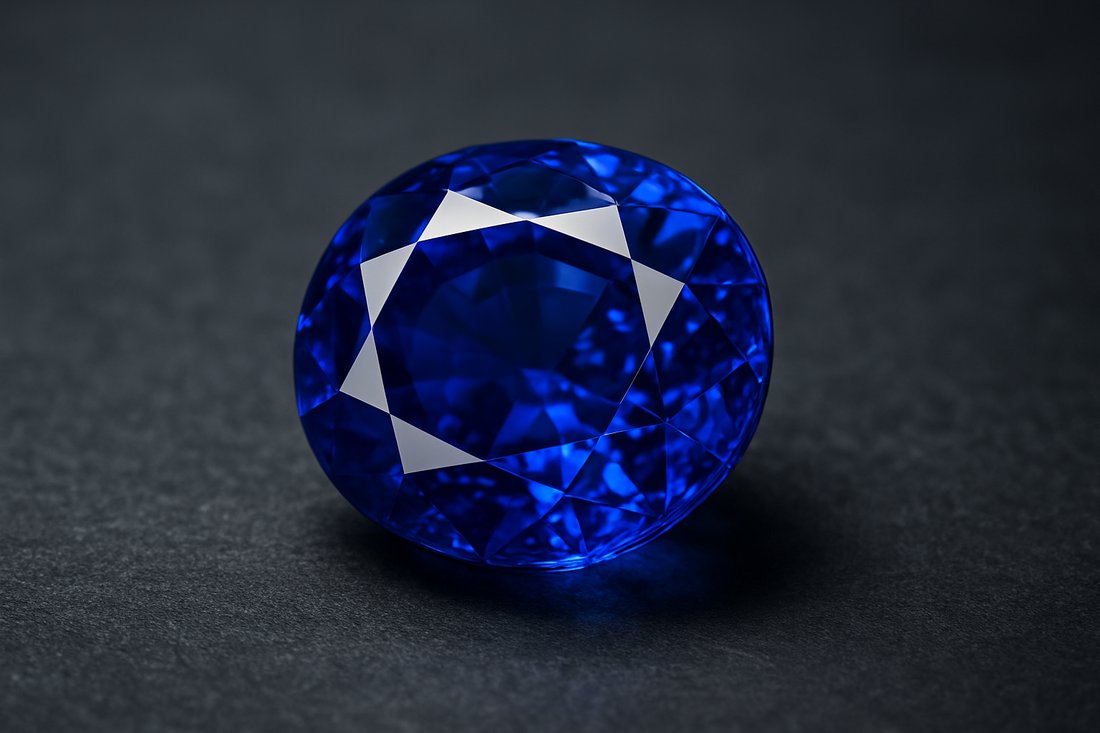
Sapphires | Properties & Value
Cody ManesShare
TL;DR
Sapphires are durable gemstones from the corundum family, prized for their vivid colors, especially blue. They symbolize wisdom, royalty, and protection. Beyond beauty, sapphires play roles in history, culture, and modern technology.
Key Facts
| Property | Details |
|---|---|
| Scientific Name | Corundum |
| Composition | Aluminum oxide (Al₂O₃) |
| Hardness | 9 on Mohs scale |
| Colors | Blue, pink, yellow, green, purple, colorless (all except red, which is ruby) |
| Treatments | Heat treatment common; diffusion and fracture filling less accepted |
| Sources | Sri Lanka, Myanmar, Madagascar, Kashmir, Australia, Montana |
| Symbolism | Wisdom, loyalty, protection, divine favor |
Q&A
Q: What makes sapphires valuable?
A: The value of sapphires depends primarily on their color, clarity, cut, and carat weight. The most prized stones display a rich, velvety cornflower blue color, especially those from Kashmir, which are famous for their intense saturation and soft luster. Clarity also plays an important role, as inclusions can lower value unless they create desirable phenomena like asterism. Cut determines how well the sapphire reflects light, and larger carat weights naturally increase rarity and demand. Collectors also place a premium on origin, with stones from Kashmir, Burma, and Sri Lanka often commanding the highest prices.
Q: Can sapphires be synthetic?
A: Yes. Synthetic sapphires have been produced since the early 1900s when Auguste Verneuil developed the flame-fusion method. These lab-grown stones share the same chemical composition, hardness, and optical properties as natural sapphires. However, because they can be made in large quantities and with fewer imperfections, they are significantly less valuable in the gem market. Despite this, synthetic sapphires are highly useful in industrial applications such as scratch-resistant watch crystals, scientific instruments, and laser technology. In jewelry, they can provide affordable alternatives to natural gems, though disclosure of their origin is ethically required.
Q: What are fancy sapphires?
A: Sapphires that are not blue are referred to as fancy sapphires. These stones occur in a wide range of hues, including yellow, pink, green, violet, and orange. Among these, Padparadscha sapphires, which display a delicate pinkish-orange color, are especially rare and valuable. Fancy sapphires derive their colors from different trace elements, such as chromium creating pink, or iron influencing yellow and green tones. Collectors and designers value these stones for their uniqueness, and certain colors may be more desirable depending on cultural preferences and market trends.
Q: What is a star sapphire?
A: A star sapphire is a type of sapphire that exhibits a phenomenon known as asterism, where a star-like pattern of light appears on the stone’s surface when viewed under a single light source. This effect is caused by needle-like inclusions of the mineral rutile aligning within the sapphire’s crystal structure. To best display the star, these gems are cut en cabochon rather than faceted. The most desirable star sapphires show sharp, well-centered stars with six distinct rays. Rarely, twelve-rayed stars may also occur. Historically, these gems were considered protective talismans, believed to guard travelers and bring good fortune.
Q: Are sapphires ethically sourced?
A: Concerns exist regarding the environmental and social impact of sapphire mining. In some regions, mining has led to deforestation, soil erosion, and water pollution, while workers may face unsafe conditions and low wages. In response, organizations and gem dealers are promoting fair-trade and ethically sourced sapphires. This includes traceability programs that track stones from mine to market, ensuring responsible labor practices and community benefits. Consumers seeking ethically sourced sapphires should look for certifications or buy from dealers who are transparent about their supply chains. Ethical sourcing not only protects the environment and workers but also supports the long-term sustainability of the gemstone trade.
Deep Dive
Mineralogy and Composition
Sapphires belong to the corundum mineral family and are composed of aluminum oxide with trace elements like iron, titanium, chromium, or vanadium that give them their colors. Their exceptional hardness, second only to diamond, makes them ideal for both jewelry and industrial uses.
In addition to their durability, sapphires are crystallized in the trigonal system, which influences their optical properties and brilliance. This crystal structure allows pleochroism, where a sapphire may show slightly different shades depending on the viewing angle. Gemologists use this property, along with refractive index testing, to help distinguish natural sapphires from imitations. The study of sapphire crystal formation also provides valuable insights into geological processes deep within the Earth’s crust, making them not only treasured gemstones but also windows into planetary science.
Colors and Varieties
The most famous sapphires are deep blue, colored primarily by trace amounts of iron and titanium. Yet sapphires span nearly the full color spectrum. Padparadscha sapphires, rare orange-pink gems from Sri Lanka, are among the most valuable non-blue varieties.
Some sapphires display color zoning, where different shades appear in distinct bands due to variations in trace elements during crystal growth. This natural phenomenon can help gemologists identify a stone’s origin and authenticity. Advanced spectroscopy has revealed that even minor differences in iron or chromium concentration can dramatically change a sapphire’s appearance, making these gems valuable study subjects for both geology and gemology. Collectors often prize stones with unusual zoning or rare hues, as they showcase the complex geological processes that shaped them over millions of years.
Treatments and Enhancements
Treatments are common in the sapphire trade. Heat treatment enhances color and clarity, while more invasive methods like diffusion or fracture filling are less accepted among gem collectors. Knowing whether a sapphire has been treated can significantly affect its value.
Some treatments, such as lattice diffusion, introduce elements like beryllium deep into the crystal structure, producing vivid colors that do not naturally occur in that stone. Advanced laboratories can detect these enhancements using spectroscopy and microscopy, which is why gemstone certification is vital for high-value purchases. Understanding these processes not only helps buyers make informed decisions but also supports transparency and trust in the global sapphire market.
Synthetic Production and Technology
Synthetic sapphires have been produced since Auguste Verneuil developed the flame-fusion process in 1902. Today, lab-grown sapphires are used not only in jewelry but also in technology, such as watch crystals, lasers, and durable smartphone components.
Modern research has expanded their use into quantum computing, where synthetic sapphire substrates provide a stable platform for superconducting circuits. Their resistance to heat and radiation also makes them valuable for space exploration instruments. These developments show that lab-grown sapphire is more than an alternative to natural gemstones, playing an essential role in advancing high-tech industries and future technologies.
Global Sources and History
Sapphires have been mined for thousands of years, with notable deposits in Sri Lanka, Myanmar, and the famed Kashmir region of India. More recently, Madagascar and Montana have become important sources. Historically, they were symbols of divine favor and protection, often used in religious and royal regalia.
Ancient trade routes carried sapphires across continents, with merchants from the Silk Road introducing these gems to Europe and the Middle East. In medieval times, clergy and royalty wore sapphires as talismans believed to guard against envy and harm. Archaeological evidence also shows that sapphires were engraved into seals and amulets, reflecting their dual role as both ornamental jewels and protective spiritual objects. This cross-cultural exchange helped establish sapphires as enduring symbols of power and sacredness in global history.
Care and Maintenance
Caring for sapphires is straightforward. Their hardness makes them durable, but they should still be protected from sharp blows. Cleaning with warm soapy water is safe for untreated and heat-treated stones, but more care should be taken with fracture-filled or heavily treated sapphires.
Professional gemologists recommend periodic inspections to check for loose settings, especially in rings and bracelets where sapphires may face more impact. Ultrasonic and steam cleaners should generally be avoided unless the stone is confirmed untreated, since vibrations and heat can damage filled fractures or diffusion-treated stones. Proper storage in soft fabric pouches also prevents scratches from contact with harder gems like diamonds. These gemstone care practices preserve both the beauty and long-term value of sapphires, which are increasingly sought after in the jewelry and collector markets.
Sources
Hughes, Richard W. Ruby & Sapphire: A Collector’s Guide. RWH Publishing, 2017.
Ward, Fred. Rubies & Sapphires, Fourth Edition. Gem Book Publishers, 2003.
